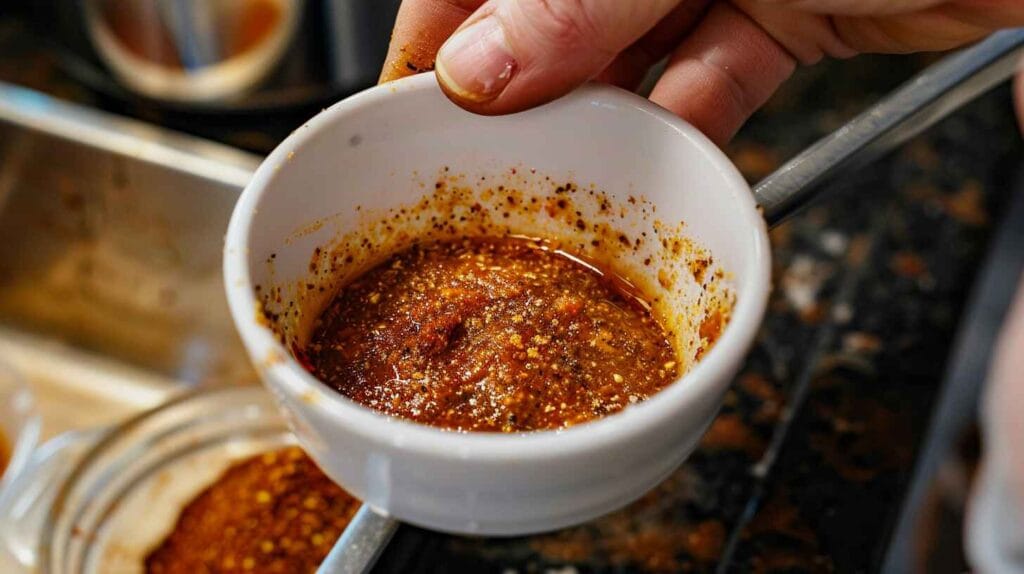Table of Contents
Can You Make Chili Less Salty? We’ve all faced that frustrating moment – after hours of simmering, you give your child a taste, only to realize it’s too salty. You might think it’s ruined, but the good news is there are plenty of ways to salvage the dish. Whether you accidentally added too much salt or an ingredient naturally intensified the flavor, you don’t have to toss out your hard work.
In this guide, we’ll explore why chili can become too salty, how to fix it using simple kitchen techniques, and preventative measures to avoid this problem in the future. By the end, you’ll be equipped with practical solutions to save your dish and enhance your cooking skills.
Why Is Chili Sometimes Too Salty (and How to Fix Salty Chili)?
Before diving into solutions, it helps to understand why chili sometimes becomes overly salty. By identifying the root cause, you can better apply the proper fix and avoid repeating the same mistake.
Common Causes of Over-Salting Chili (Why Chili Gets Too Salty)
- Adding Too Much Salt Early On – Seasoning too heavily during the early stages of cooking can lead to excessive saltiness as the chili reduces and flavors concentrate.
- Using Pre-Seasoned Ingredients – Canned beans, tomato sauces, and broths often contain added salt. If you’re not careful, combining these ingredients can lead to an overpowering salt flavor.
- Mistakes in Measurement – A simple miscalculation or accidental heavy-handed pour can throw off the balance of your chili.
- Evaporation During Simmering – As chili simmers, water evaporates, intensifying all the flavors, including salt.
Cooking Techniques That Can Increase Saltiness (and Make Chili Too Salty)
- Slow Reduction – Simmering chili for long periods can reduce the liquid, making the overall dish more concentrated and salty.
- Using Salty Toppings or Mix-Ins – Adding ingredients like cheese, bacon, or salty meats after cooking the chili can also increase the saltiness.
The key takeaway? Sometimes, over-salting isn’t just about adding too much salt – it’s about how the cooking process intensifies flavors. Luckily, there are easy ways to restore balance.
How to Make Chili Less Salty (Easy Ways to Fix Salty Chili)

Don’t panic if your chili tastes like the ocean – there are several tried-and-true techniques to bring the salt level back to a more enjoyable balance. Below are the best methods to rescue salty chili without compromising flavor.
Dilution Techniques to Make Chili Less Salty
Dilution is one of the fastest ways to reduce salt concentration. Increasing the liquid content can spread the salt across a larger volume, making it less noticeable.
- Add More Liquid
- Pour in unsalted broth, water, or tomato juice to thin the chili and reduce the saltiness. Start with a half-cup and stir well. Try it out. Add more if you like.
- Avoid over-diluting. If the chili becomes too thin, you can simmer it again to thicken (without adding more salt).
- Increase Bulk with Ingredients
- Add more beans, ground beef, or diced tomatoes to increase the quantity of the chili without changing its flavor significantly. These ingredients absorb some of the salt while adding more substance.
- Corn or bell peppers are also great additions that complement chili flavors while helping balance the salt.
- Incorporate Potatoes
- Potatoes are excellent at absorbing excess salt. Peel and dice one or two potatoes and add them to the chili while simmering. Remove them after about 20-30 minutes. The potatoes will take on some of the salt without altering the flavor.
Ingredient Balance to Reduce Saltiness in Chili

Sometimes, balancing salty chili can be as simple as adding ingredients that counteract the saltiness.
- Vegetables and Beans
- Throw additional vegetables, beans, or lentils to bulk up the dish and neutralize the saltiness. Black beans, kidney beans, or chickpeas are all solid choices.
- Mushrooms or zucchini can also add volume without drastically changing the flavor profile.
- More Meat
- If your child has a meat base, browning more ground beef, turkey, or sausage and mixing it in can help dilute the salt. This adds protein while balancing the seasoning.
Acidity and Sweetness to Fix Salty Chili
Acid and sweetness can mask excessive salt and restore harmony to your chili’s flavor profile.
- Add Vinegar or Lemon Juice
- A splash of vinegar (apple cider or white vinegar) or fresh lemon juice can cut through saltiness. The acidity distracts your palate from the overwhelming salt.
- Start with one teaspoon, stir, and taste. Repeat if necessary.
- Incorporate Sugar or Honey
- A small amount of sugar, honey, or maple syrup can balance out salty flavors.
- Add 1-2 teaspoons gradually until the flavor smooths out. Be careful not to make the chili overly sweet.
Dairy and Starches to Neutralize Salty Chili
Dairy and starchy ingredients work well to mellow out intense, salty flavors.
- Add Dairy Products
- Stir in a dollop of sour cream, plain yogurt, or shredded cheese. These creamy additions tone down the saltiness while adding richness to the chili.
- If your chili isn’t too spicy, cream cheese or heavy cream can also be effective.
- Incorporate Grains and Starches
- Adding cooked rice, pasta, or quinoa directly to the chili thickens it and reduces the overall salt concentration.
- Another option is to serve the chili over rice or baked potatoes, reducing the perceived saltiness in each bite.
Preventing Over-Salting in the Future (Tips to Avoid Salty Chili)
While fixing salty chili is applicable, the best solution is to avoid over-salting in the first place. Adopting a few smart cooking habits ensures your chili turns out perfectly seasoned every time. Here are some preventative tips to keep your child balanced and flavorful.
Taste Testing Frequently During Cooking to Prevent Salty Chili
Tasting as you cook is one of the simplest and most effective ways to avoid over-salting. Instead of adding all the salt at once, season gradually and adjust based on taste.
- Taste After Each Addition – After each round of seasoning, give your child a taste to check for balance. Salt levels can change during simmering, so frequent sampling is essential.
- Season in Layers – Salt lightly at the beginning and add small amounts throughout the cooking process. This layering technique builds flavor without overwhelming the dish.
Use Low-Sodium Ingredients to Prevent Salty Chili
Many canned or packaged ingredients used in chili contain hidden salt. Opting for low-sodium alternatives can significantly reduce the risk of over-salting.
- Canned Beans and Tomatoes
- Search for salt-free or low-sodium canned tomatoes and beans. These provide the same flavor and texture without the added salt.
- If you only have regular canned goods, rinse beans thoroughly under cold water before adding them to the chili to remove excess salt.
- Broths and Stocks
- Always choose low-sodium broth or stock. This allows you to control the salt content during the cooking process.
- If using homemade broth, taste it beforehand to ensure it’s not too salty.
Add Salt Gradually
It’s much easier to add salt than it is to take it away. By salting gradually, you can avoid reaching the point where the chili becomes too salty.
- Salt in Small Increments – Start with a pinch and increase slowly. Simmering intensifies flavors, so even a tiny amount of salt can grow stronger.
- Use Measuring Spoons – Avoid adding salt directly from the shaker. Use measuring spoons to control the amount precisely.
Alternative Seasoning Options
If you’re worried about over-salting, consider using other seasoning methods to enhance flavor without relying solely on salt.
- Herbs and Spices
- Boost the flavor of your chili with a mix of herbs like cilantro, oregano, or cumin to make chili less salty. These ingredients add depth without increasing sodium levels, helping you balance the dish naturally.
- Experiment with garlic powder, smoked paprika, or chili powder to create bold flavors that don’t depend on salt, providing another way to fix salty chili and enhance taste.
- Natural Flavor Enhancers
- A dash of citrus juice, vinegar, or even cocoa powder can elevate the taste of chili without the need for extra salt.
- Umami-rich ingredients like soy sauce (low-sodium), miso, or tomato paste can intensify flavor in a balanced way.
By incorporating these strategies into your cooking routine, you can confidently season your chili and avoid the dreaded over-salted outcome.
Alternative Seasoning Options
Sometimes, the best way to avoid over-salting chili is to rely on ingredients that enhance flavor naturally. Salt isn’t the only way to bring out the richness in your chili – plenty of herbs, spices, and umami-packed alternatives can make your dish just as delicious. Let’s dive into the best options to season chili without going overboard on salt.
Herbs and Spices for Flavor Without Extra Salt
Using a blend of aromatic herbs and bold spices can add layers of flavor, reducing the need for excessive salt.
- Cumin
- Cumin’s warm, earthy flavor is essential in chili and can help make chili less salty by enhancing the overall taste without adding salt.
- Toast cumin seeds lightly before adding them to release even more flavor, providing a natural way to fix salty chili and deepen its richness.
- Smoked Paprika
- Smoked paprika brings a smoky, rich undertone to chili. It creates depth without increasing sodium levels.
- Mix it with spices like garlic powder or coriander for a complex flavor.
- Chili Powder and Cayenne Pepper
- Chili powder adds warmth and a spicy kick. Use it to boost the heat and reduce the need for salty flavor.
- Cayenne pepper intensifies spice levels, further distracting from saltiness.
- Oregano and Thyme
- Dried oregano adds a slight bitterness that balances out salty and sweet flavors. Thyme provides an earthy tone that pairs well with tomatoes and beans.
- These herbs are great sprinkled during cooking or as a finishing touch.
- Bay Leaves
- Adding a couple of bay leaves while simmering infuses the chili with subtle, savory notes.
- Remove the leaves before serving.
Natural Flavor Enhancers
Flavor boosters like umami-rich ingredients or tangy acids can make your chili pop without leaning on salt.
- Tomato Paste
- A spoonful of concentrated tomato paste intensifies the flavor of chili without increasing the salt content.
- Simmer it with onions and garlic at the start to caramelize and deepen the taste.
- Cocoa Powder or Dark Chocolate
- This might sound unusual, but a pinch of unsweetened cocoa powder or a small piece of dark chocolate can enrich the chili’s flavor.
- It balances the acidity of tomatoes and reduces the need for more salt.
- Vinegar or Citrus Juice
- Adding apple cider vinegar, lime juice, or lemon juice brightens chili and cuts through excess saltiness.
- Begin with a teaspoon, and alter according to your taste.
- Mushrooms
- Mushrooms are natural umami bombs. Adding sautéed mushrooms to your chili enhances the savory elements.
- Finely chop or blend them into the base for extra depth.
Garlic, Onion, and Aromatics
Aromatic ingredients like garlic, onion, and shallots are foundational in chili. They contribute to the overall flavor and reduce the need for salt when used generously.
- Caramelize onions and garlic slowly to bring out their natural sweetness. This sweetness balances the salt.
- Add roasted garlic for a milder, richer flavor that enhances the dish.
Umami-Packed Additions
Umami” the “fifth taste,” is well-known for its delicious depth. Incorporating umami ingredients can reduce reliance on salt while elevating the flavor profile.
- Miso Paste (Low Sodium)
- Stir a small amount of miso paste into the chili towards the end of cooking. It provides richness without a strong salty bite.
- Nutritional Yeast
- Nutritional yeast has a cheesy, nutty flavor that complements chili. Sprinkle a tablespoon in to add depth.
- Worcestershire Sauce (Low-Sodium Version)
- Worcestershire sauce introduces layers of umami, enhancing the meatiness of chili. Use sparingly to avoid adding too much salt.
Cooking Techniques to Boost Flavor
Even without extra seasoning, specific cooking techniques can intensify flavors and enrich your chili taste.
- Roasting Vegetables
- Roast your tomatoes, peppers, and garlic before adding them to the chili. This enhances their natural sweetness and reduces the need for salt.
- Searing Meat
- Brown your meat nicely before simmering it in the chili. This caramelization process adds umami and richness, reducing the need for excessive seasoning.
Frequently Asked Questions (FAQ):
If you’ve ever faced the problem of overly salty chili, you’re not alone. Many home cooks run into this issue, and questions arise about the best way to correct it. Below are frequently asked questions and detailed answers to help you rescue your dish like a pro.
How Much Vinegar Should I Add to Reduce Saltiness?
Start with one teaspoon of vinegar (apple cider, white, or red wine) and stir well. Taste and add more if needed. Too much acidity can overpower the dish. Learn more about balancing flavors in How to Make Salmon Soup Less Fishy – Easy Tips.
Does Adding Sugar Help with Salty Chili?
Yes! Add ½ teaspoon sugar, honey, or maple syrup, stir, and taste. Gradually add more if needed to balance the salt. For sweet-savory tips, check out Birthday Cake Popcorn – A Sweet Celebration in Every Bite.
Can I Add More Chili Powder if It’s Too Salty?
Adding chili powder or spices won’t reduce salt but can mask it. Combine with broth or extra beans for best results. Try this Sodium Chili Recipe – Hearty, Rich, and Easy to Make.
Will Adding Milk or Cream Change the Flavor Too Much?
Dairy reduces saltiness but adds creaminess. Use sour cream, heavy cream, or yogurt. For creamy dishes, explore The Ultimate Tini’s Mac and Cheese Recipe.
How Long Should I Simmer Chili After Fixing Salt?
Simmer to meld flavors for 10-15 minutes after adding liquid or vegetables. For more simmering tips, visit Salmon Soup Recipe – Quick and Easy to Warm Your Soul.
Can I Freeze Salty Chili and Fix It Later?
Yes! Freezing mellows flavors. Adjust salt when reheating by adding broth, beans, or dairy. For freezing tips, read Can You Eat Beans After 7 Days in the Fridge?
Conclusion
Making chili is rewarding, but even the most experienced cooks can accidentally over-salt their dish. The good news is that salty chili doesn’t have to be a disaster. You can bring your child back to perfection with the proper techniques – from dilution and ingredient balancing to incorporating acidity, sweetness, and dairy.
Understanding why chili becomes too salty in the first place can help prevent this issue. Taste frequently, add salt gradually, and rely on herbs, spices, and umami-rich ingredients to enhance flavor without overdoing the salt. And remember, sometimes the most straightforward fix – like tossing in extra beans or a splash of vinegar – can make all the difference.
Cooking is as much about learning from mistakes as following recipes. So, the next time your child feels like it spent too long at the beach, you’ll know how to bring it back to balance and serve a hearty, delicious bowl. Happy cooking!
